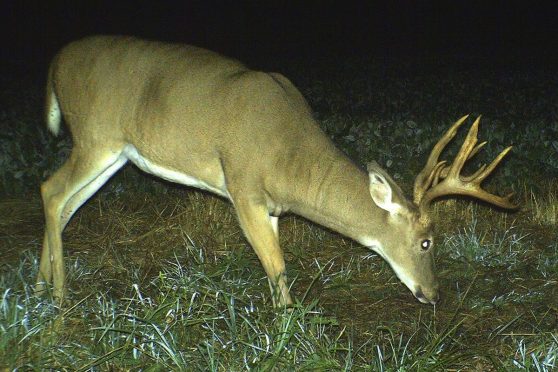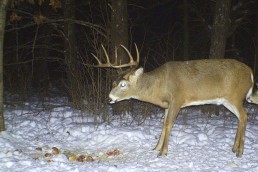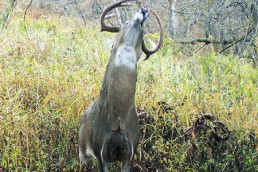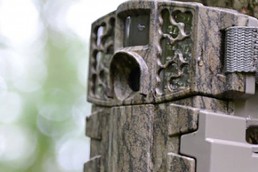Trail Camera Timeline
SHARE THIS POST
Tools are used for monitoring deer movements, but the “trail camera,” or use of the game camera, has now also become a sport. Camera users have come up with all kinds of creative ways to use these to monitor wildlife activity and to learn more about many different animals. But most deer hunters still bring these cameras out well before the season and then store them away after the hunt is over. This can be a mistake. The more you learn about deer any month, the better your chances are of shooting one come fall.
Don’t put your trail cameras away after the season. Your cameras should be placed in areas throughout the calendar year to help you learn more about whitetails so you can increase your odds of bagging a big one.
January-April
Once the hunting season is over I move my cameras to feeding sites. The winter weather concentrates the deer in areas where there is food available. I usually have a couple of sites I put out feed, which allows me to get photos of the area deer. Cameras can be placed on food plots and bedding areas, and the trails left in the snow are obvious.
You can also monitor the shedding of antlers. Knowing when the bone hits the ground allows you to get out there and pick up the sheds before others get to them. I start seeing bucks without antlers in numbers by the end of January. The majority of these antlers are on the ground by the first or second week in March.
May-August
These are the months to put your cameras on mineral sites. Most all deer in the area will visit sites laced with a good mineral attractant. Some will show up regularly, and some only a couple times a month, but if your cameras aren’t out there you won’t get a look at the deer. I use Monster Raxx mineral and keep it replenished each time I check the cameras, usually twice a month. This product has worked very well for me and it really helps me inventory all the bucks in my area.

By the end of August, hunting season is getting close. This is when I start to transition some of the cameras to trails around the feeding sites. I’ll learn which fields the whitetails are feeding in. Placing cameras on the trails will help me pattern where they’re moving and what times they’re likely coming through. This information can be invaluable when hunting season opens just weeks later.
September-October
By the first of September I have all my cameras on the trails related to the food sources. The bucks are in their bachelor groups, and it’s a fun time to get lots of photos of them as their antlers become fully mature and they shed their velvet the first week of the month. Keep in mind that the food sources may not be the most obvious ones.
The deer feeding in alfalfa and soybeans are the most visible, but there may be a lot of deer also feeding on freshly fallen acorns, hazelnuts and other mast crops. Archery season up here in Minnesota opens in mid-September, so it’s hard to overstate the value of the placement of trail cameras during the first half of the month.
Through the second half of September and into the first half of October, the bachelor groups are breaking up and the cameras can really help you keep track of where these bucks are going. Trails associated with feeding patters seem to offer the best sites, but by the second half of October things will radically change.
Are you enjoying this post?
You can be among the first to get the latest info on where to go, what to use and how to use it!

By the middle of October, scrapes and rubs are showing up throughout my hunting areas and I’m carefully moving some cameras as I see the transition being made from food-focused movements to breeding-focused patterns. By the end of October, most all my cameras are on scrapes. I use scrape drippers to monitor the deer visits and inventory the bucks. (See YouTube video.) There’s no better way to get a picture of all the bucks in the area than by having a camera on a primary scrape at the end of the month.
November
By the first week in November I’ve put my cameras on the does. To find the bucks, you must first find the does. You need to know where they’re bedding, where they’re feeding and how they’re traveling between the two areas. I have my cameras in doe bedding areas and on trails between the bedding areas and trails leading to food sources. The first three weeks of November is peak breeding time across most of the whitetail’s range in North America. The movements of bucks will seem totally random, and in a sense they are, but they will be looking for does.
One mistake many make during this time is checking the cameras too often. You’re seeing nice bucks every time you pull the SD cards and you really want to get back in there and look at it again. However, for best results, you want to minimize intrusion into these areas so you don’t change the patterns of these area does and lose the information you have gained, or make them become nocturnal. Resist the temptation to check the cameras until you really need the info to make an informed decision on where and how to hunt.
By the last 10 days of November, the rut is winding down. Now you should have your cameras on pinch points and travel corridors where the bucks will be moving through while they’re looking for the last remaining does that have not been bred. Pick places that up your odds of catching one of these bucks on their feet. The scrapes that have been ignored for the past two weeks get some more attention too.
December
The rut is over and the focus is back on the food. Deer are looking for foods high in carbohydrates to replenish fat reserves lost during the rut. They need to combat the cold and their bodies are craving the carbs found in corn and whatever acorns may be left over. Cut cornfields and standing crops are the best places to find both the bucks and does. They are once again grouped up, and deer of all ages and stature will be found together around the best food sources.

At this time, deer will also bed in predictable places. On sunny days, they tend to choose south slopes of hills near food sources where they can soak up the solar energy. On nasty, cold or cloudy days, they tend to head for the thickest cover around. Either way, they need to feed and the trails leading to the food sources are where your cameras should already be located or where they should be repositioned. This will help you learn which deer made it through the season and which did not. It will also help you fill that last-minute bow tag if you are still carrying one in your pocket.
So, if you have put your cameras away for the year, dig them back out and get them out in the right locations. It’s great fun, great exercise, and you’ll be amazed at the information you will gather.
Watch a video of Bernie Barringer, as he shows how to attract a big buck with a mock scrape, at the MidWestOutdoors.com Home Page in the “Most Recent Six” section.
MWO
SHARE THIS POST
Did you enjoy this post?
You can be among the first to get the latest info on where to go, what to use and how to use it!
Bernie Barringer
Bernie Barringer has hunted big game with a bow in more than a dozen states and in multiple Canadian provinces. Passion drives him to learn more and hunt new places, and this column is your ticket to his travels. The author of 13 books and thousands of articles, you can find even more from him at bowhuntingroad.com and BowhuntingRoad on YouTube.



